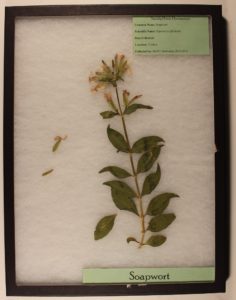| Common Name(s) | Soapwort, Bouncing-bet, Crow Soap, Soapweed | ||||
| Scientific Name | Saponaria officinalis | ||||
| Family | Caryophllales | ||||
| Location/Vegetative Zone | Thicket | ||||
| Flowering Period | May-September | ||||
| Identifying Characteristics | purple and white flowers, sweet smell, red-tinged stems without branches | ||||
Description
- Leafy, unbranched stems with opposite leaves
- leaves are between 4 and 12 cm long
- grows in patches
- Purple, sometimes white flowers that emit a sweet smelling nectar
- Found in the thicket
- Distributed across North America
Cultural Uses
- Can be used as a strong soap
- Especially useful for delicate fabrics
- A natural soap and shampoo, but NOT in excess!
- The Pennsylvania Dutch used it to make the foamy head on beer
Misc
- Self-pollinates
- Visited by bumblebees and hoverflies
Sources
Seward, Marc. “Benefits and Uses of Soapwort”. Healthy Focus. 8 April 2017. Web.
Bergeron, Karen and Deb Jackson. “Soapwort”. Altnature. Web.
1,705 total views, 1 views today

